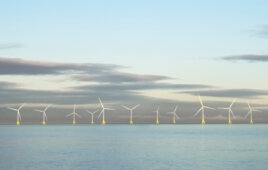
Using Gamesa’s 2.0-MW turbine as a laboratory, researchers will study the behavior of systems and how new designs, products, and equipment can affect performance.
The public-private partnership will develop innovations that will enhance the capabilities and performance of advanced wind systems in tapping the vast potential of this renewable energy resource and ultimately bring the nation closer to 20% wind energy by 2030.
Gamesa and NREL will collaborate on work in these key areas by developing new wind turbine components and rotors for the U.S. market, researching and testing the performance of new control strategies, and devising models that will help advance the development of offshore wind in U.S. waters.
“Wind energy is going to continue to play a key role in creating a stronger and more sustainable American economy,” said Dr. Miguel Angel Gonzalez-Posada, Vice President of Technology for Gamesa North America. Gamesa has installed and commissioned a G97 Class IIIA 2.0 MW test wind turbine at NREL’s National Wind Technology Center near Boulder, Colorado.
“These types of collaborations demonstrate a commitment to crucial technology development and the public-private partnerships necessary to ensure continued momentum of the wind-power industry,” says NREL’s Deputy Laboratory Director for Science and Technology Dana Christensen. “Our role with the Department of Energy is to reduce technical risks and thereby help accelerate next generation technology into the marketplace. NREL is proud to be at the forefront of this important work.”
Since its introduction last year, Gamesa’s G9X-2.0 MW turbine platform has gained recognition for its blade design, updated nacelle, enhanced control systems, and other features that substantially increase energy output. The G97 Class IIIA 2.0 MW model, which will serve as the test platform with NREL, is intended for low-wind sites, a segment from which Gamesa expects over half of all future on-shore demand.
Gamesa and NREL also will work to design and test new lightning protection and other turbine conditioning systems, examining their performances in a range of temperatures at high altitude to ensure that they function in us environments. New converters will be used to test ways to increase energy output while enhancing component reliability. Extensive tests also will be conducted on other turbine key components, examining motion, temperatures, stresses and vibration levels, where the findings could lead to improvements that enhance the reliability of future us installations.
Control strategies: The two organizations also will work to develop new control strategies that improve energy capture while decreasing loads, which will be accomplished through development of new algorithms. New control strategies will be tested throughout the turbine. Testing will include measurement of aerodynamic loads, the response of blade profiles, and pitch actuation. Output will be measured to determine how changes affect power output and its fluctuations, and what the effects are on structural loads and the drive-train response.
Offshore wind: NREL and Gamesa will conduct a round-robin exercise using existing turbine modeling software to develop new methods that will let companies predict the behavior of offshore wind turbines, as well as the potential sensitivity of equipment to the offshore environment. The two organizations will examine factors such as wind-speed distribution, turbulence intensity and wind shear, waves, tides, currents, temperature, lightning and ice formation, and how these factors correlate with performance and the potential cost for the design, operation and maintenance of offshore wind systems.
“This research project will examine every aspect of the turbine, from its base to the blade tip at its apex, along with all the parts that make it turn,” said Gonzalez-Posada. Full project testing on the entire slate of programs began January 2012. The core provisions of the public-private partnership run through 2013, with options for two additional years of collaboration.
NREL
https://www.windpowerengineering.com/directory/?s=National+Renewable+Energy+Lab&searchsubmit=Search
Gamesa Technology Corp.
https://www.windpowerengineering.com/directory/?s=Gamesa&searchsubmit=Search
Filed Under: News, Turbines




